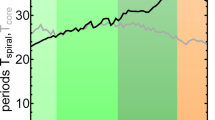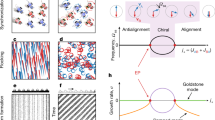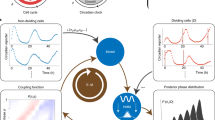Abstract
The coexistence of coherent and incoherent dynamics in a population of identically coupled oscillators is known as a chimera state1,2. Discovered in 20023, this counterintuitive dynamical behaviour has inspired extensive theoretical and experimental activity4,5,6,7,8,9,10,11,12,13,14,15. The spiral wave chimera is a particularly remarkable chimera state, in which an ordered spiral wave rotates around a core consisting of asynchronous oscillators. Spiral wave chimeras were theoretically predicted in 200416 and numerically studied in a variety of systems17,18,19,20,21,22,23. Here, we report their experimental verification using large populations of nonlocally coupled Belousov–Zhabotinsky chemical oscillators10,18 in a two-dimensional array. We characterize previously unreported spatiotemporal dynamics, including erratic motion of the asynchronous spiral core, growth and splitting of the cores, as well as the transition from the chimera state to disordered behaviour. Spiral wave chimeras are likely to occur in other systems with long-range interactions, such as cortical tissues24, cilia carpets25, SQUID metamaterials26 and arrays of optomechanical oscillators9.
This is a preview of subscription content, access via your institution
Access options
Access Nature and 54 other Nature Portfolio journals
Get Nature+, our best-value online-access subscription
$29.99 / 30 days
cancel any time
Subscribe to this journal
Receive 12 print issues and online access
$209.00 per year
only $17.42 per issue
Buy this article
- Purchase on Springer Link
- Instant access to full article PDF
Prices may be subject to local taxes which are calculated during checkout



Similar content being viewed by others
References
Abrams, D. M. & Strogatz, S. H. Chimera states for coupled oscillators. Phys. Rev. Lett. 93, 174102 (2004).
Panaggio, M. J. & Abrams, D. M. Chimera states: coexistence of coherence and incoherence in networks of coupled oscillators. Nonlinearity 28, R67 (2015).
Kuramoto, Y. & Battogtokh, D. Coexistence of coherence and incoherence in nonlocally coupled phase oscillators. Nonlin. Phenom. Complex Syst. 5, 380–385 (2002).
Zakharova, A., Kapeller, M. & Schöll, E. Chimera death: symmetry breaking in dynamical networks. Phys. Rev. Lett. 112, 154101 (2014).
Abrams, D. M., Mirollo, R., Strogatz, S. H. & Wiley, D. A. Solvable model for chimera states of coupled oscillators. Phys. Rev. Lett. 101, 084103 (2008).
Wolfrum, M. & Omel’chenko, O. E. Chimera states are chaotic transients. Phys. Rev. E 84, 015201 (2011).
Sethia, G. C., Sen, A. & Atay, F. M. Clustered chimera states in delay-coupled oscillator systems. Phys. Rev. Lett. 100, 144102 (2008).
Schmidt, L., Schönleber, K., Krischer, K. & García-Morales, V. Coexistence of synchrony and incoherence in oscillatory media under nonlinear global coupling. Chaos 24, 013102 (2014).
Hagerstrom, A. M. et al. Experimental observation of chimeras in coupled-map lattices. Nat. Phys. 8, 658–661 (2012).
Tinsley, M. R., Nkomo, S. & Showalter, K. Chimera and phase-cluster states in populations of coupled chemical oscillators. Nat. Phys. 8, 662–665 (2012).
Martens, E. A., Thutupalli, S., Fourrière, A. & Hallatschek, O. Chimera states in mechanical oscillator networks. Proc. Natl Acad. Sci. USA 110, 10563–10567 (2013).
Wojewoda, J., Czolczynski, K., Maistrenko, Y. & Kapitaniak, T. The smallest chimera state for coupled pendula. Sci. Rep. 6, 34329 (2016).
Wickramasinghe, M. & Kiss, I. Z. Spatially organized dynamical states in chemical oscillator networks: synchronization, dynamical differentiation, and chimera patterns. PLoS ONE 8, e80586 (2013).
Larger, L., Penkovsky, B. & Maistrenko, Y. Laser chimeras as a paradigm for multistable patterns in complex systems. Nat. Commun. 6, 7752 (2015).
Rosin, D. P., Rontani, D., Haynes, N. D., Schöll, E. & Gauthier, D. J. Transient scaling and resurgence of chimera states in networks of Boolean phase oscillators. Phys. Rev. E 90, 030902 (2014).
Shima, S. & Kuramoto, Y. Rotating spiral waves with phase-randomized core in nonlocally coupled oscillators. Phys. Rev. E 69, 036213 (2004).
Martens, E. A., Laing, C. R. & Strogatz, S. H. Solvable model of spiral wave chimeras. Phys. Rev. Lett. 104, 044101 (2010).
Nkomo, S., Tinsley, M. R. & Showalter, K. Chimera states in populations of nonlocally coupled chemical oscillators. Phys. Rev. Lett. 110, 244102 (2013).
Gu, C., St-Yves, G. & Davidsen, J. Spiral wave chimeras in complex oscillatory and chaotic systems. Phys. Rev. Lett. 111, 134101 (2013).
Tang, X. et al. Novel type of chimera spiral waves arising from decoupling of a diffusible component. J. Chem. Phys. 141, 024110 (2014).
Xie, J. B., Knobloch, E. & Kao, H. C. Twisted chimera states and multicore spiral chimera states on a two-dimensional torus. Phys. Rev. E 92, 042921 (2015).
Lau, H. W. & Davidsen, J. Linked and knotted chimera filaments in oscillatory systems. Phys. Rev. E 94, 010204 (2016).
Laing, C. R. Chimeras in two-dimensional domains: heterogeneity and the continuum limit. SIAM J. Appl. Dyn. Sys. 16, 974–1014 (2017).
Huang, X. et al. Spiral waves in disinhibited mammalian neocortex. J. Neurosci. 24, 9897–9902 (2004).
Uchida, N. & Golestanian, R. Synchronization and collective dynamics in a carpet of microfluidic rotors. Phys. Rev. Lett. 104, 178103 (2010).
Lazarides, N., Neofotistos, G. & Tsironis, G. P. Chimeras in SQUID metamaterials. Phys. Rev. B 91, 054303 (2015).
Winfree, A. T. The Geometry of Biological Time (Springer, New York, 2001).
Zhabotinsky, A. M., Buchholtz, F., Kiyatkin, A. B. & Epstein, I. R. Oscillations and waves in metal-ion-catalyzed bromate oscillating reactions in highly oxidized states. J. Phys. Chem. 97, 7578–7584 (1993).
Davidsen, J., Glass, L. & Kapral, R. Topological constraints on spiral wave dynamics in spherical geometries with inhomogeneous excitability. Phys. Rev. E 70, 056203 (2004).
Canavier, C. C. & Achuthan, S. Pulse coupled oscillators and the phase resetting curve. Math. Biosci. 226, 77–96 (2010).
Taylor, A. F. et al. Clusters and switchers in globally coupled photochemical oscillators. Phys. Rev. Lett. 100, 214101 (2008).
Totz, J. F. et al. Phase-lag synchronization in networks of coupled chemical oscillators. Phys. Rev. E 92, 022819 (2015).
Nkomo, S., Tinsley, M. R. & Showalter, K. Chimera and chimera-like states in populations of nonlocally coupled homogeneous and heterogeneous chemical oscillators. Chaos 26, 094826 (2016).
Acknowledgements
The authors thank J. Sixt and F. Sielaff from TU Berlin Physics Department’s precision mechanical workshop for preparing the acrylic glass plates with micrometre-sized cavities that hold the micro-oscillators and U. Künkel for assistance in the laboratory. This work was supported by the Deutsche Forschungsgemeinschaft (grants GRK 1558 and SFB 910 to J.F.T., J.R. and H.E.), the National Science Foundation (grant CHE-1565665 to K.S. and M.R.T.) and the Alexander von Humboldt-Stiftung (to K.S.).
Author information
Authors and Affiliations
Contributions
J.F.T. and J.R. built and programmed the set-up and performed experiments. J.F.T., K.S. and H.E. designed the study and wrote the paper. The simulations were carried out by J.F.T. and J.R., except for those shown in Fig. 3b–i, which were done by M.R.T. All authors discussed the results and commented on the manuscript.
Corresponding authors
Ethics declarations
Competing interests
The authors declare no competing financial interests.
Additional information
Publisher’s note: Springer Nature remains neutral with regard to jurisdictional claims in published maps and institutional affiliations.
Electronic supplementary material
Supplementary Information
Supplementary Figures 1–5, Supplementary Tables 1,2, Supplementary Note 1 and Supplementary references
Rights and permissions
About this article
Cite this article
Totz, J.F., Rode, J., Tinsley, M.R. et al. Spiral wave chimera states in large populations of coupled chemical oscillators. Nature Phys 14, 282–285 (2018). https://doi.org/10.1038/s41567-017-0005-8
Received:
Accepted:
Published:
Issue Date:
DOI: https://doi.org/10.1038/s41567-017-0005-8
This article is cited by
-
Emergence of large-scale mechanical spiral waves in bacterial living matter
Nature Physics (2024)
-
Spiral wave chimeras in populations of oscillators coupled to a slowly varying diffusive environment
Frontiers of Physics (2023)
-
Embedded chimera states in recurrent neural networks
Communications Physics (2022)
-
Phase response approaches to neural activity models with distributed delay
Biological Cybernetics (2022)
-
Chimera states and cluster solutions in Hindmarsh-Rose neural networks with state resetting process
Cognitive Neurodynamics (2022)



